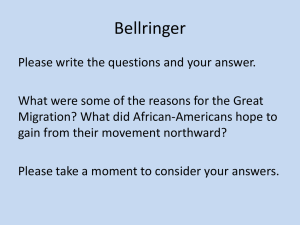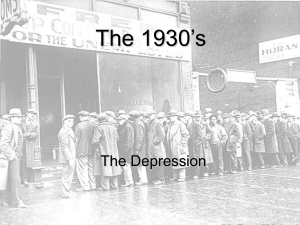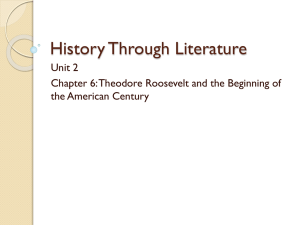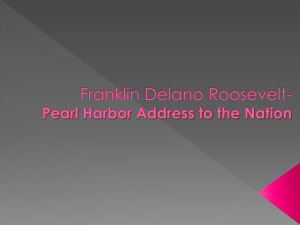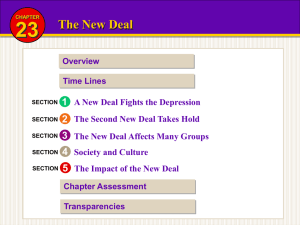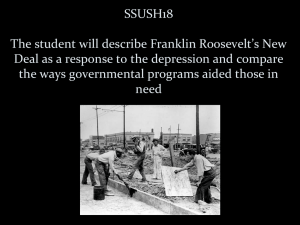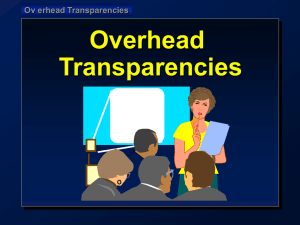09 TAJMT Chapter 11
advertisement
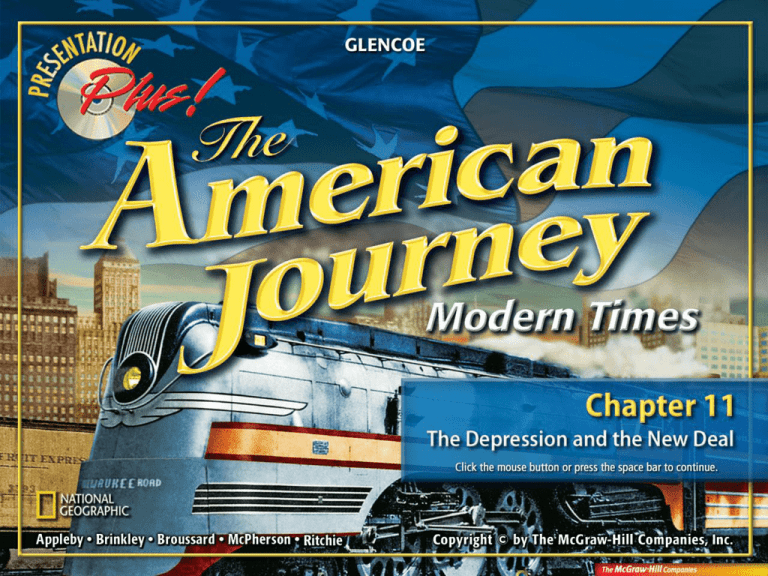
Chapter Introduction Section 1: The Great Depression Section 2: Roosevelt’s New Deal Section 3: Life During the Depression Section 4: Effects of the New Deal Visual Summary The Great Depression Essential Question What were the factors that brought about the Great Depression? Roosevelt’s New Deal Essential Question How did Franklin Roosevelt’s leadership bring about change in the U.S. economy? Life During the Depression Essential Question How did the Great Depression affect the economic and social traditions of Americans, especially minorities? Effects of the New Deal Essential Question Why did some people support Roosevelt’s New Deal and some oppose it? What were the factors that brought about the Great Depression? Reading Guide Content Vocabulary • stock exchange • relief • default • public works Academic Vocabulary • decline • collapse Reading Guide (cont.) Key People and Events • “Black Thursday” • Great Depression • Hooverville • Bonus Army How would you prefer to invest your money? A. High risk, with a possibility of high reward A C. Low risk, with a possibility of small rewards B A. A B. B C. C0% 0% 0% C B. Medium risk, with a possibility of decent reward The Stock Market The stock market crash of 1929 signaled an end to the prosperity of the 1920s. The Stock Market (cont.) • A stock exchange is an organized system for buying and selling shares in corporations. • The rising prices of stock in the late 1920s encouraged many Americans to buy shares on margin, paying only a fraction of the stock price while borrowing the rest from brokers. • Fearing that the boom market would end, investors began selling stock in late September. The Stock Market (cont.) • Prices declined sharply, and panicked traders sold 13 million shares on October 24, also known as “Black Thursday.” Looking for Jobs What day is known as “Black Thursday”? A. January 1, 1929 B. April 15, 1929 C. September 11, 1929 D. October 24, 1929 0% A A. B. C. 0% D. B A B C 0% D C 0% D The Great Depression The Great Depression, a worldwide economic slump, brought hardship to many Americans during the 1930s. The Great Depression (cont.) • The Great Depression—a severe economic crisis that started in the late 1920s—was not caused by the stock market crash alone. – Farm income dropped throughout the 1920s. – The automotive and construction industries experienced lagging sales and laid off workers. Surviving the Depression The Great Depression (cont.) – The gap in wealth between rich and poor fueled the Depression. – In the 1920s, the economy was greatly fueled by money borrowed from banks. – Many small banks suffered when farmers defaulted on their loans. – Some large banks collapsed after suffering huge losses from the stock market crash. The Great Depression (cont.) • With increased tariffs and fewer loans from American banks, foreign countries purchased fewer American products. • During the Depression, millions of Americans lost their jobs or received reduced wages. • Many families lived in shelters built from old boxes and formed communities known as Hoovervilles. What hardship did more than 20 percent of Americans face during the Great Depression? A. Inflation B. Unemployment C. Scarcity of goods D. High stock prices 0% A A. B. C. 0% D. B A B C 0% D C 0% D Hoover and the Crisis Herbert Hoover gradually involved the federal government in the economic crisis. Hoover and the Crisis (cont.) • Initially, President Hoover and Congress took no legislative action to help with the Depression and called on charities, churches, and volunteers to provide relief for those in need. • In 1931, Hoover authorized federal spending on public works to create new jobs. Hoover and the Crisis (cont.) • In the summer of 1932, veterans of World War I known as the Bonus Army marched to Washington, D.C., to demand early payment of bonuses that were to be paid to them in 1945. • President Hoover called in the army after scuffles broke out and two veterans were killed. The Bonus Army was comprised of veterans from what war? A. The Revolutionary War B. The Civil War C. The Spanish-American War D. World War I 0% A A. B. C. 0% D. B A B C 0% D C 0% D How did Franklin Roosevelt’s leadership bring about change in the U.S. economy? Reading Guide Content Vocabulary • work relief Academic Vocabulary • promote • generate Reading Guide (cont.) Key People and Events • Franklin D. Roosevelt • Eleanor Roosevelt • Hundred Days • New Deal • Tennessee Valley Authority Rate your agreement with the following statement: Government should have a large involvement in regulating business. C. Somewhat disagree A D. Strongly disagree C B. Somewhat agree B A. A B. B C. C 0% D.0% D0% 0% D A. Strongly agree Franklin D. Roosevelt Franklin D. Roosevelt promised a “new deal” to get America out of the Great Depression. Franklin D. Roosevelt (cont.) • Franklin D. Roosevelt, a wealthy Democrat from New York and distant cousin to President Theodore Roosevelt, ran against President Hoover in the election of 1932. – He married Eleanor Roosevelt, who actively worked alongside Franklin in his political life, in 1905. – Despite being struck with polio, leaving his legs paralyzed, Roosevelt refused to give in and remained in politics. Franklin D. Roosevelt (cont.) – Roosevelt was elected governor of New York in 1928 and 1930, earning a reputation as a reformer. America Tunes In What was the name of the group who advised Franklin D. Roosevelt? A. The Brain Trust B. The New Deal C. The Bonus Army D. The Tennessee Valley Authority 0% A A. B. C. 0% D. B A B C 0% D C 0% D FDR Takes Charge Roosevelt quickly launched programs to improve the American economy. FDR Takes Charge (cont.) • As president, Roosevelt’s primary tasks were to put people to work and help the nation’s failed banks. • Roosevelt’s proposals for new economic programs were quickly approved by Congress during a period that came to be called the Hundred Days. What was Roosevelt’s primary task when he took office? A. To win the war B. To decrease states’ rights 0% 0% D A D. To decrease unemployment C C. To expand the territory of the United States A B C 0% D B A. B. C. 0% D. The New Deal Takes Shape Roosevelt’s New Deal affected many areas of American life, including banking, the stock market, industry, agriculture, and welfare. The New Deal Takes Shape (cont.) • The new laws passed by Congress during the Hundred Days and after came to be known as the New Deal. – Work relief programs gave government jobs to needy people through the Civilian Conservation Corps. – The poor received aid through the Federal Emergency Relief Administration. New Deal Programs The New Deal Takes Shape (cont.) – The Agricultural Adjustment Act raised farm prices and controlled production. – The Tennessee Valley Authority aimed to control flooding and promote conservation while generating electricity for rural areas in the South. – The National Industrial Recovery Act was created to boost the economy and help business regulate itself. New Deal Programs The New Deal Takes Shape (cont.) – The Federal Deposit Insurance Corporation was created to insure bank deposits. – The Securities and Exchange Commission regulated the sale of stocks and bonds. New Deal Programs The New Deal Takes Shape (cont.) • The New Deal did not cure the nation’s ills; however, the flurry of activity did restore some confidence to Americans. New Deal Programs What program under the New Deal built hydroelectric plants which provided cheap electricity to thousands of farms and homes in some Southern states? A. Public Works Administration 0% 0% D A B C 0% D C D. Agricultural Adjustment Act A C. National Recovery Administration A. B. C. 0% D. B B. Tennessee Valley Authority How did the Great Depression affect the economic and social traditions of Americans, especially minorities? Reading Guide Content Vocabulary • migrant worker • fascist Academic Vocabulary • migrate • advocate Reading Guide (cont.) Key People and Events • Frances Perkins • Dust Bowl • Ralph Bunche • Mary McLeod Bethune • Indian Reorganization Act • Spanish Civil War Would you be willing to move out of the country if the government offered to pay for your trip? A. Yes B. No A. A B. B 0% B A 0% Hard Times in America The Depression was a difficult time because many Americans faced unemployment and the loss of land and other property. Hard Times in America (cont.) • During the Depression, many women went to work even though they earned less than men. • Frances Perkins was the first woman to serve in a cabinet position. • Eleanor Roosevelt vigorously campaigned for women and families in need. Hard Times in America (cont.) • “Black blizzards” were dust storms in the Southern Great Plains brought on by the combination of severe drought and farmers clearing millions of acres of sod for wheat farming. • The area that included western Kansas and Oklahoma, northern Texas, and eastern Colorado and New Mexico became known as the Dust Bowl. The Dust Bowl Hard Times in America (cont.) • Thousands of Dust Bowl farmers went bankrupt and migrated to California and became migrant workers. Teenage Hoboes Which of the following states was NOT part of the Dust Bowl? A. California B. Colorado C. Oklahoma D. Texas 0% A A. B. C. 0% D. B A B C 0% D C 0% D The Plight of Minorities The Great Depression placed the hardest burden on minority groups. It also led to the growth of radical political movements. The Plight of Minorities (cont.) • During the Depression, more than half of the African Americans in the South were unemployed, and many migrated to Northern cities in search of opportunity. • President Roosevelt had a group of advisors known as the Black Cabinet that included Ralph Bunche and Mary McLeod Bethune. The Plight of Minorities (cont.) • The Indian Reorganization Act of 1934 restored traditional tribal government and provided money for land purchases to enlarge some reservations. • During the Depression, the government encouraged Mexican immigrants to return to Mexico. Those that stayed faced a great deal of discrimination. The Plight of Minorities (cont.) • Radical groups that advocated extreme and immediate change gained ground during the Depression. – Communism attracted some Americans with promises to end economic and racial injustice. – Fascists advocated government by dictatorship. During the Spanish Civil War more than 3,000 Americans went to Spain to fight the fascists. Whom did the government encourage to leave the country during the Great Depression? A. Native Americans B. African Americans C. Dust Bowl families D. Mexican Americans 0% A A. B. C. 0% D. B A B C 0% D C 0% D Entertainment and the Arts The 1930s was a golden age of entertainment, literature, music, and art. Entertainment and the Arts (cont.) • Two trends in entertainment and the arts emerged from the Depression. – Escapism—light or romantic entertainment—helped people to forget about their problems. – Social criticism depicted the injustice and suffering in Depression America. Entertainment and the Arts (cont.) • Radio programs and movies were enormously popular during the 1930s. • Many writers, photographers, and painters portrayed the grim realities of Depression life. Which novel explored the topic of farm families fleeing the Dust Bowl? A. Superman B. The Wizard of Oz C. The Grapes of Wrath D. Gone with the Wind 0% A A. B. C. 0% D. B A B C 0% D C 0% D Why did some people support Roosevelt’s New Deal and some oppose it? Reading Guide Content Vocabulary • pension • unemployment insurance Academic Vocabulary • scheme • welfare Reading Guide (cont.) Key People and Events • Second New Deal • Social Security Act • John L. Lewis • Fair Labor Standards Act Rate your agreement on the following statement: Social Security will still exist when you retire from your job. A D. Strongly disagree 0% 0% 0% 0% D C. Somewhat disagree A B C D C B. Somewhat agree A. B. C. D. B A. Strongly agree Critics of the New Deal During the mid-1930s, Roosevelt’s New Deal programs faced growing opposition. Critics of the New Deal (cont.) • Business leaders felt threatened by the government’s expansion of power and wanted government to leave them alone and play a less active role in the economy. • Others felt the government was not doing enough and developed schemes to help the average American. – Father Charles Coughlin used a weekly radio program to flaunt his extreme views. Critics of the New Deal (cont.) – Francis Townsend called for a monthly pension for older, retired people. – Senator Huey Long called for heavy taxation of the rich. Which of the following men was assassinated by a political opponent? A. Franklin Roosevelt B. Huey Long C. Francis Townsend D. Charles Coughlin 0% A A. B. C. 0% D. B A B C 0% D C 0% D The Second New Deal Roosevelt’s Second New Deal introduced new programs to help jobless workers, the elderly, and labor unions. The Second New Deal (cont.) • In 1935 President Roosevelt launched a new set of programs and reforms, often called the Second New Deal. – To help generate new jobs, Congress created the Works Progress Administration. WPA Projects The Second New Deal (cont.) – The Social Security Act established a tax on workers to provide monthly pensions for retired people. The act launched the American welfare system. – A tax on employers funded unemployment insurance payments to people who lost their jobs. The Second New Deal (cont.) • John L. Lewis and the Congress of Industrial Organizations set out to organize unions that included skilled and unskilled workers. • The Fair Labor Standards Act banned child labor and set a minimum wage. Who funds the Social Security Act? A. Employers B. Government C. Workers D. Workers and employers 0% A A. B. C. 0% D. B A B C 0% D C 0% D The Supreme Court Roosevelt’s Second New Deal was challenged by the Supreme Court. The Supreme Court (cont.) • In 1935, the Supreme Court began to declare New Deal legislation unconstitutional. • After being reelected in 1936, Roosevelt asked Congress to increase the number of justices on the Supreme Court from 9 to 15 so he could fill the six new positions with justices who would uphold his New Deal. The Supreme Court (cont.) • When the Supreme Court ruled in favor of the Wagner Act and the Social Security Act, the issue was dropped. How many justices are on the Supreme Court? A. 5 B. 9 C. 11 D. 15 0% A A. B. C. 0% D. B A B C 0% D C 0% D Section Transparencies Menu Daily Test Practice Transparency 25–1 Lesson Transparency 25A Select a transparency to view. Section Transparencies Menu Daily Test Practice Transparency 25–2 Lesson Transparency 25B Select a transparency to view. Section Transparencies Menu Daily Test Practice Transparency 25–3 Select a transparency to view. Section Transparencies Menu Daily Test Practice Transparency 25–4 Lesson Transparency 25C Select a transparency to view. stock exchange a place where shares in corporations are bought and sold through an organized system default to fail to meet an obligation, especially a financial one relief aid for the needy; welfare public works projects such as highways, parks, and libraries built with public funds for public use decline descend collapse break down work relief programs that gave needy people government jobs promote to help advance generate create migrant worker a person who moves from place to place to find work harvesting fruits and vegetables fascist a person with extremely nationalistic views migrate relocate advocate support pension a sum paid regularly to a person, usually after retirement unemployment insurance payments by the government for a limited period of time to people who have lost their jobs scheme a plan welfare standard care; well-being To use this Presentation Plus! product: Click the Forward button to go to the next slide. Click the Previous button to return to the previous slide. Click the Home button to return to the Chapter Menu. Click the Transparency button from within a section to access the transparencies that are relevant to the section. Click the Return button in a feature to return to the main presentation. Click the History Online button to access online textbook features. Click the Reference Atlas button to access the Interactive Reference Atlas. Click the Exit button or press the Escape key [Esc] to end the chapter slide show. Click the Help button to access this screen. Links to Presentation Plus! features such as Maps in Motion, Graphs in Motion, Charts in Motion, Concepts in Motion, figures from your textbook, and Section Spotlight Videos are located at the bottom of relevant screens. This slide is intentionally blank.

